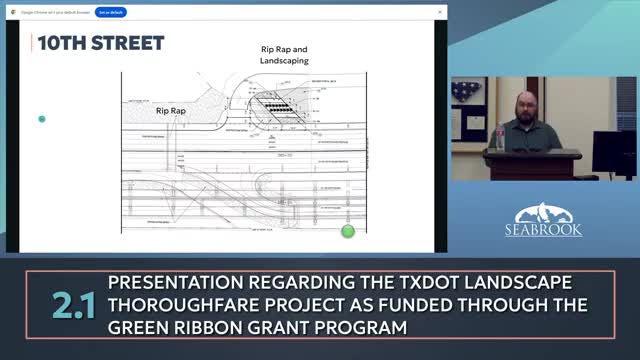City tackles irrigation plans amidst landscaping frustrations at TxDOT site
November 07, 2024 | Seabrook, Harris County, Texas
This article was created by AI summarizing key points discussed. AI makes mistakes, so for full details and context, please refer to the video of the full meeting. Please report any errors so we can fix them. Report an error »

In a recent workshop held on November 7, 2024, the City of Seabrook's City Council and Open Space & Trails Committee engaged in a detailed discussion regarding the ongoing landscaping and irrigation projects along major roadways, particularly in relation to the Texas Department of Transportation (TxDOT) requirements. The meeting highlighted the complexities of urban landscaping in compliance with state regulations and the community's expectations for green spaces.
One of the primary topics was the installation of irrigation systems beneath the roadways. The contractor explained the use of a boring machine to create sleeves for irrigation pipes, which will facilitate a drip irrigation system. This method is designed to minimize water overspray onto the road, aligning with TxDOT's guidelines. However, concerns were raised about the limited ability to make changes to the landscaping plans at this stage, as any modifications would need to be funded by the city rather than TxDOT.
A significant point of contention arose regarding the aesthetic choices made for the landscaping, particularly the use of rocks instead of more greenery. One council member expressed frustration over the perceived lack of community involvement in the planning process, stating that the initial vision for a lush green space had been compromised. The member emphasized that the community had been shown images of vibrant plant life, contrasting sharply with the current rocky landscape.
The contractor acknowledged the budget constraints imposed by TxDOT, which influenced the final design. While efforts were made to incorporate more plant material, the project ultimately had to adhere to TxDOT's standards and budget limitations. The discussion revealed a broader concern about the balance between regulatory compliance and community desires for green spaces.
Additionally, the council discussed maintenance responsibilities post-construction. TxDOT will oversee maintenance for a period of 12 months after project completion, after which the city will assume responsibility. This transition raised questions about accountability for any damage that may occur during or after construction.
The meeting concluded with a call for better communication and involvement from the city in future projects to ensure that community expectations align with regulatory requirements. As Seabrook continues to develop its urban landscape, the discussions from this workshop underscore the ongoing challenges of balancing infrastructure needs with the community's vision for green spaces. The city council's commitment to addressing these issues will be crucial as they move forward with the project and future landscaping initiatives.
One of the primary topics was the installation of irrigation systems beneath the roadways. The contractor explained the use of a boring machine to create sleeves for irrigation pipes, which will facilitate a drip irrigation system. This method is designed to minimize water overspray onto the road, aligning with TxDOT's guidelines. However, concerns were raised about the limited ability to make changes to the landscaping plans at this stage, as any modifications would need to be funded by the city rather than TxDOT.
A significant point of contention arose regarding the aesthetic choices made for the landscaping, particularly the use of rocks instead of more greenery. One council member expressed frustration over the perceived lack of community involvement in the planning process, stating that the initial vision for a lush green space had been compromised. The member emphasized that the community had been shown images of vibrant plant life, contrasting sharply with the current rocky landscape.
The contractor acknowledged the budget constraints imposed by TxDOT, which influenced the final design. While efforts were made to incorporate more plant material, the project ultimately had to adhere to TxDOT's standards and budget limitations. The discussion revealed a broader concern about the balance between regulatory compliance and community desires for green spaces.
Additionally, the council discussed maintenance responsibilities post-construction. TxDOT will oversee maintenance for a period of 12 months after project completion, after which the city will assume responsibility. This transition raised questions about accountability for any damage that may occur during or after construction.
The meeting concluded with a call for better communication and involvement from the city in future projects to ensure that community expectations align with regulatory requirements. As Seabrook continues to develop its urban landscape, the discussions from this workshop underscore the ongoing challenges of balancing infrastructure needs with the community's vision for green spaces. The city council's commitment to addressing these issues will be crucial as they move forward with the project and future landscaping initiatives.
View full meeting
This article is based on a recent meeting—watch the full video and explore the complete transcript for deeper insights into the discussion.
View full meeting
